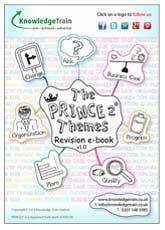This article is the second in a series of three. The other two articles cover the PRINCE2 principles and the PRINCE2 processes. They are available to download and share as e-books. They cover a lot of the content you will learn about on one of our PRINCE2 courses.
In this article we’re going to focus on the 7 PRINCE2 themes. In particular, we’re going to focus on those elements which most frequently are examined on the PRINCE2 Foundation exam.
There are 7 themes in PRINCE2, and for the Foundation examination you need to know the purpose of each of them. Rather than provide the exact quotation for the PRINCE2 manual, we will paraphrase the purposes and highlight them in light grey. The items highlighted in bold are those which are most commonly included in questions in the PRINCE2 Foundation exam.
Business Case
The purpose of this theme is to put in place mechanisms which assists the senior decision makers to decide whether the project is (and remains) a worthwhile investment.
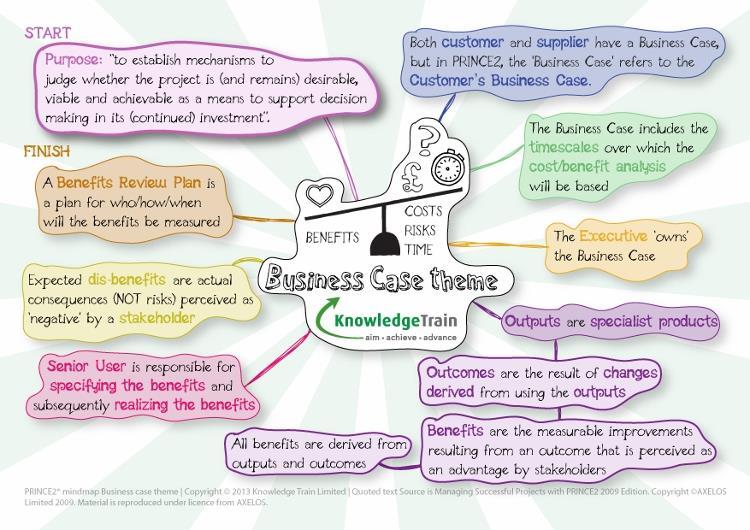
The customer, which is investing in the project will have a Business Case, but so will the supplier. Each one is written to justify it’s own involvement in the project. (Note: PRINCE2 assumes a customer-supplier environment, whereby the customer specifies what products are required from the project, pays for it and expects to realize some benefits in return. The supplier - person, team or organization - will deliver those products to the level of quality specified by the customer – see the Organization theme below).
A Business Case is also a document (it’s one of the 26 PRINCE2 management products) and is ‘owned’ by the Executive. At all times therefore, the Executive needs to ensure there is an acceptable Business Case, otherwise they should instruct the Project Manager to close the project. Not wasting any more time and money on a project is much better than continuing with a project which is not worthwhile.
The Executive is responsible for providing the first (outline) version of the Business Case although this can also sometimes be given by corporate/programme management as part of the Project Brief. This version then gets updated with more detail in the Initiation stage of the project.
Every project will deliver one or more ‘specialist’ products (known as outputs), which will then be used at the end of the project by people in the customer organization. By using them, this will change (positively) the way in which they do their everyday (business as usual) work. This change is known as an outcome. The measureable improvements which will then result to the customer organization are what are known as benefits.
For example, a company investing in a new business information computer system sets up a project. The output of the project would be the new I.T. system. The outcome might be that the staff are able to do their work more efficiently. The benefit might be that the company saves money on staff salaries.
The Senior User role is responsible for both specifying the benefits of the project, and also for realizing them i.e. make sure that they are actually achieved after the project closes. This means that the people who perform the Senior User role need to come from those areas of the customer organization which are most often impacted by the changes (outcomes).
How the benefits will be measured, when and by who is documented in a Benefits Review Plan (one of the 26 management products). This gets updated as and when the benefits are actually realized which for most projects is after the project has closed. This is because at the end of the project, the specialist products are handed over to the users and the operational or support teams. They then use the products as part of business-as-usual and by doing so, realize the expected benefits (or so we would hope!).
Organization
The purpose of this theme is to define and set up an project management team structure which defines who is accountable and responsible on the project.
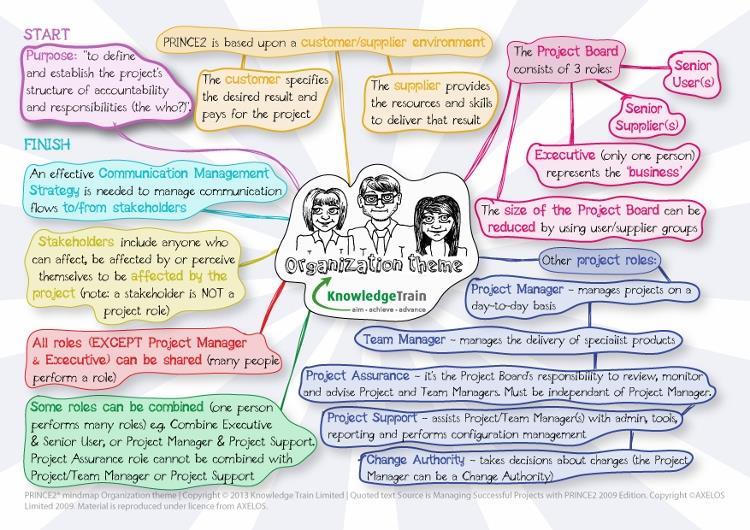
PRINCE2 is based upon a ‘customer/supplier environment’ whereby the customer organization specifies the result (the specialist products), and pays for the project, because it deems that the project is able to realize sufficient benefits in the future to make the project worthwhile.
The supplier organization is the person or company who/which will supply the products which have been specified by the customer. On a project where all the work is being done in-house, then the customer and supplier will be part of the same organization.
The key decision-making role on the project is known as the Project Board which consists of 3 other roles: Executive and Senior User (both from the customer) and the Senior Supplier (from the supplier). It’s important to note however that the Project Board is not a democracy and ultimately, it’s the Executive who takes the decisions, advised and supported by the other 2 roles.
The Executive role can only be performed by one person and must be able to represent the business i.e. that part of the customer organization which is paying for the project). This role is ultimately accountable for the project.
The Senior User role which is responsible for specifying and realizing benefits is also responsible for specifying the project’s requirements and products.
The Senior Supplier is accountable for the quality of the specialist products which they will deliver to the project.
Reviewing project documentation such as plans and business cases could be quite time-consuming so PRINCE2 recommends that Project Assurance can be delegated by the Project Board members to others. The Project Assurance role is all about assuring the Project Board independently of the Project Manager that the project is being conducted properly. Project Assurance will give advice to the Project Manager and will review documents prior to their approval by the Project Board.
The Project Manager role is responsible for the day to day management of the project and reports on a regular basis the progress to the Project Board. The Project Manager is responsible for keeping issues and risks under control, monitoring progress, taking corrective action when there is a slippage from the plan, and escalating exceptions to the Project Board.
Team Managers manage teams of specialists who have the requisite skills to enable them to design and build the products which have been specified by the customer. They are responsible for delivering the specialist products, on time and within the agreed tolerances. They report on a regular basis to the Project Manager.
The Change Authority role is responsible for taking decisions about Requests for Change (RFC’s) and Off-Specifications (more later in the Change theme).
The Project Support role assists Project and Team Managers with administration, writing of reports, monitoring of progress and with administering tools.
Some of the above roles can be shared (i.e. more than one person can perform the role). In PRINCE2 all roles can be shared EXCEPT for the Executive and Project Manager roles.
Some roles can be combined (i.e. one person can perform multiple roles). However, the Project Assurance role can never be shared with the Project Manager, Team Manager or Project Support roles, otherwise they would not be independent of the Project Manager.
All of the above roles form the project management team and they are all stakeholders on the project. However stakeholders are not just the members of the project management team, but they can be anyone who is affected by the project.
PRINCE2 recommends that a Communication Management Strategy is written which identifies all of the project’s stakeholders, their information needs and the means and frequency of communication e.g. the Quality Assurance Manager requires a copy of the weekly Highlight Report, written by the Project Manager.
Quality
The purpose of this theme is to define and implement the mechanisms whereby the project can establish whether the products are ‘fit for purpose’.
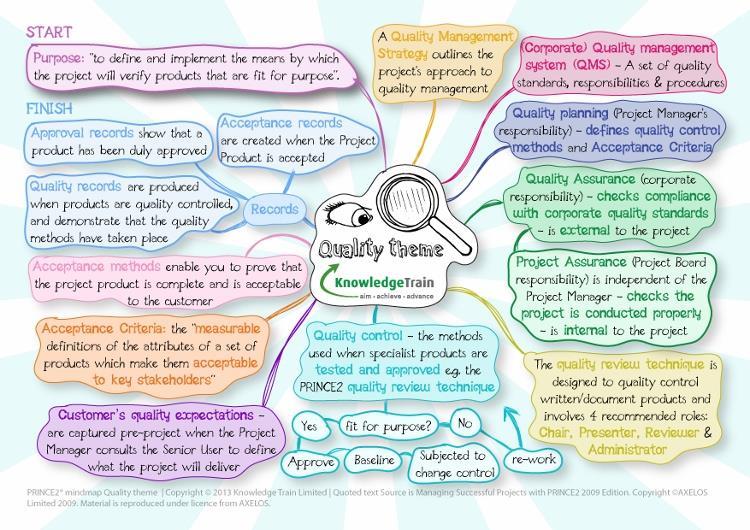
PRINCE2 defines quality as whether or not a product is ‘fit for purpose’ i.e. whether it meets its agreed and stated requirements. The theme also covers implementation of continuous improvement methods during the project e.g. methods designed to improve the effectiveness of the project management processes.
The project’s approach to the management of quality on the project is documented by the Project Manager in a Quality Management Strategy.
Many organizations have a quality management system (QMS) which is a corporate-wide set of quality policies, procedures and standards expected within the organization. The corporate role known as Quality Assurance (QA) is responsible for defining and maintaining the QMS and for checking that projects remains in compliance. QA often does this by performing a quality audit which looks for evidence of compliance on the project.
The QA role is therefore external to the project whereas Project Assurance is a role which is internal to the project (it’s one of the project management team roles). Project Assurance assures the Project Board that the project is being conducted properly whereas QA assures corporate management that the project is in compliance with corporate standards, policies and procedures.
QA is not to be confused with quality control, which refers to the performing of those techniques and methods which will be used to check if a product is “fit for purpose”, the maintaining of quality and approval records, and the gaining of acceptance.
There are hundreds of such quality techniques to choose from and one example is PRINCE2’s quality review technique which is suitable for reviewing the quality of paper-based documents. PRINCE2 defines four roles which are involved in such a review: Chair, Presenter, Reviewer and Administrator.
During the quality method, quality records will be maintained e.g. the details of the results of a test and then, based upon the results, the product shall be judged either fit for purpose or not. If it is fit for purpose then the product can be approved and approval records will be needed. This is often a signature on a form or an email.
Once approved the product becomes a baseline. This usually entails giving it a version number and it then becomes subject to change control i.e. nobody is allowed to modify it without gaining approval after raising a Request for Change (RFC).
If the product is not fit for purpose, the supplier needs to perform some re-work on the product to bring it up to a standard where it can be quality controlled once more.
On a project, the Project Manager is responsible for quality planning which entails defining the quality control methods and the project’s acceptance criteria (the measurable attributes of the final product i.e. the product handed over to users at the end which will make it acceptable to the customer). Acceptance criteria are derived from the customer’s quality expectations which are the high level business requirements for the project and these are agreed before the project begins.
Certain methods (acceptance methods) will need to be performed to check that the final product meets the criteria. If it does, then the project can be closed because it has delivered what it set out to deliver. Acceptance records will record the formal acceptance of the final product by the different stakeholders.
Plans
The purpose of this theme is to define how, when, for how much, by whom and where the project will deliver products.
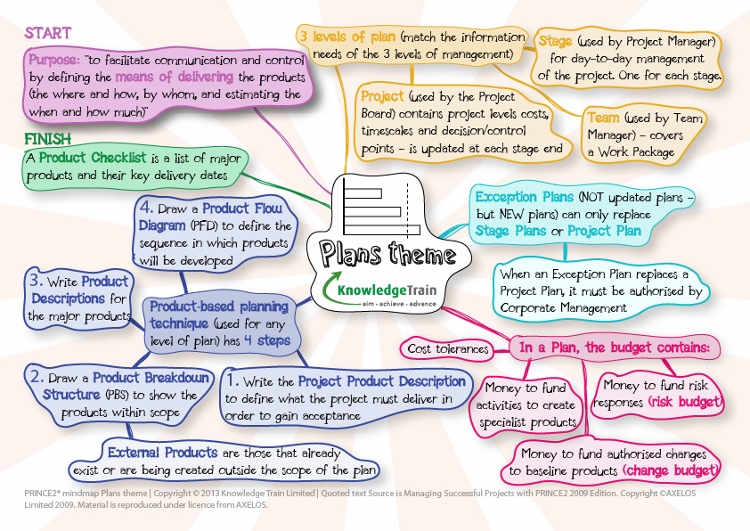
PRINCE2 recommends 3 levels of plan each level matching the information needs of the 3 levels of the project management team. These are
- Project Plan (used by the Project Board) containing project levels costs, timescales and control points. An updated version is created at each stage end to reflect actual progress and revised forecasts;
- Stage Plan (used by the Project Manager) for day-to-day management of the project. There is one for each management stage;
- Team Plan (used by a Team Manager) – covers all the work done in a Work Package.
It’s important to remember that Exception Plans are new plans (not updated versions of existing plans) and they can be used to replace Stage Plans or the Project Plan. In the latter case, it must be authorised by corporate management.
Plans not only specify which products will be delivered in the scope of the plan, but also the timescales and costs required. PRINCE2 recommends the following are included in the budget for a Plan:
- money to fund the activities to create specialist products (and management activities);
- money to fund responses to risks (risk budget);
- money to fund authorised changes to baseline products (change budget);
- cost tolerance.
It’s recommended that the product-based planning technique can be used for all levels of plan). The technique has 4 steps:
- Write the Project Product Description to define what the project must deliver in order to gain acceptance;
- Draw a Product Breakdown Structure to show the products within scope (note: external products are those that already exist or are being created outside the scope of the plan);
- Write Product Descriptions for the major products;
- Draw a Product Flow Diagram to define the sequence in which the products will be developed.
Sometimes a product checklist which lists the major products and their key delivery dates is a useful control on a project. (Note: a product checklist is not a PRINCE2 management product).
Risk
The purpose of this theme is to identify, analyse and control uncertainty and thereby improve the chances of a successful project.
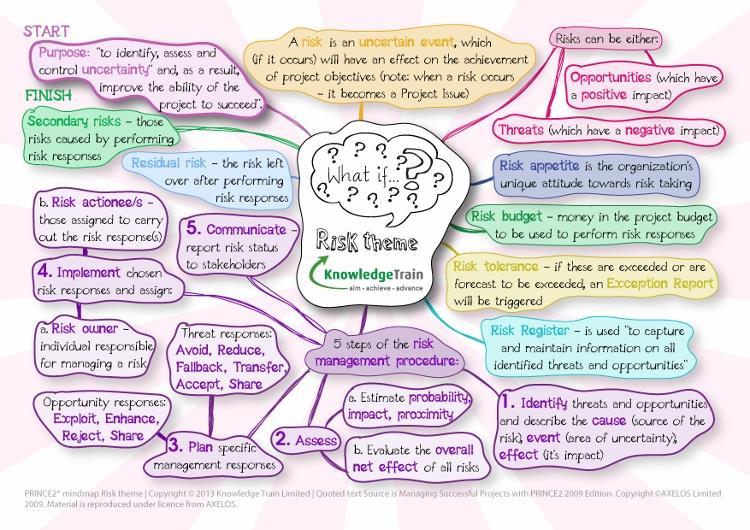
In PRINCE2, a risk is defined as an uncertain event, which (if it does occur) will have an effect (either negative or positive) on the project’s objectives. A risk should NOT be confused with a Project Issue, which is an event which has happened but wasn’t planned. However, if and when a risk does actually occur then it becomes a Project Issue.
Risks can be either:
- threats (which have a negative impact), or
- opportunities (which have a positive impact).
Every organization has its own unique attitude towards risk taking. This is known as risk appetite.
Each plan in PRINCE2 will have a risk budget, which is money to be used to fund any risk responses.
Risk tolerance refers to the threshold level of risk, which once exceeded (or forecast to be exceeded) will result in an Exception Report being triggered i.e. an exception has occurred.
Information about all project risks are maintained in a Risk Register, and a Risk Management Strategy is written to outline the general approach to risk management during the project.
Included in this strategy is a description of the risk management procedure which contains 5 steps:
- Identify - threats and opportunities are identified and described in terms of the cause (source of the risk), event (area of uncertainty), and effect (it’s impact).
- Assess
- Estimate the probability (likelihood), impact, proximity, and
- Evaluate the overall net effect of all risks.
- Plan one or more specific risk responses.
- Implement the chosen risk responses and assign:
- A risk owner – the individual responsible for managing the risk
- The risk actionee/s – the people assigned to carry out the risk response(s).
- Communicate – report risk information to stakeholders using the various PRINCE2 reports.
PRINCE2 defines 6 responses to threats: avoid, reduce, fallback, transfer, accept, share, and 4 responses to opportunities: exploit, enhance, reject, share.
After performing these responses to primary risks, there is usually some level of risk left over. This is known as residual risk. Any risks caused by performing risk responses are known as secondary risks.
Change
The purpose is to identify, analyse and control any potential and approved changes to baseline products (i.e. products that have been approved).
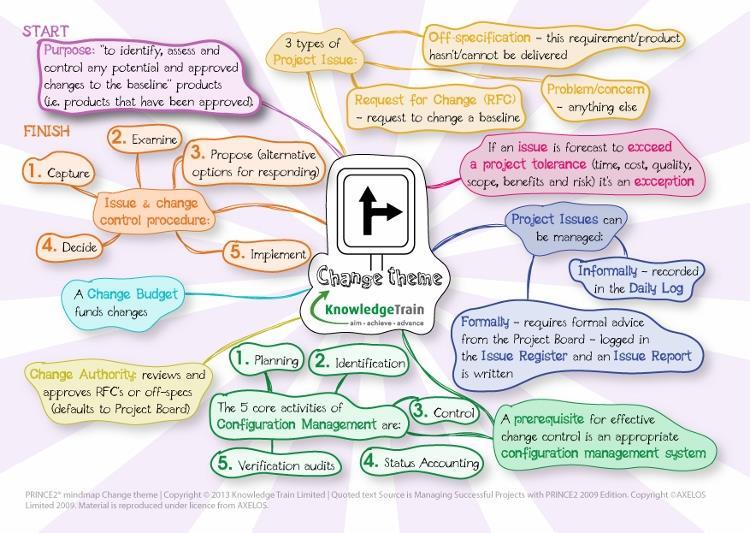
A baseline refers to a product which has undergone its quality controls, has been deemed ‘fit for purpose’ and has been approved by those with authority. At this point the product is usually given a version number e.g. version 1.0).
There are 3 types of Project Issue:
- Requests for Change (RFC) - request to change a baseline.
- Off-specifications - this requirement/product hasn’t/cannot be delivered.
- Problems/concerns – anything else.
If a Project Issue is forecast to exceed a project tolerance (time, cost, quality, scope, benefits and risk) it’s an exception.
Project Issues can be managed in 2 ways:
- Formally - requires formal advice from the Project Board – the issue gets logged in the Issue Register and an Issue Report is written.
- Informally – the issue gets recorded in the Daily Log.
All issues are managed using an issue & change control procedure:
- Capture – either in the Issue Register or Daily Log (as above);
- Examine – perform an impact analysis (impact on cost, time, quality, scope, benefits, risks);
- Propose - alternative options for responding;
- Decide – which option is the best overall value for money;
- Implement – perform the recommended option(s).
A Change Authority reviews and approves RFC’s and off-specifications and by default is performed by the Project Board. A Change Budget is used to fund changes.
A prerequisite for effective change control is an appropriate configuration management system. The 5 core activities of configuration management are:
- Planning – decide how it will be done, which tools are required;
- Identification – decide a version and naming schema;
- Control – decide who will have access to products and able to make changes to baselines;
- Status Accounting – decide how configuration status reports (Product Status Accounts) will be created;
- Verification audits – decide how/when will the status of products will be checked against the status which has been recorded.
Progress
The purpose is to put in place mechanisms to monitor and compare what’s actually happened on the project against what should have happened, to control deviations from the baseline and to provide forecasts for the remainder of the project.
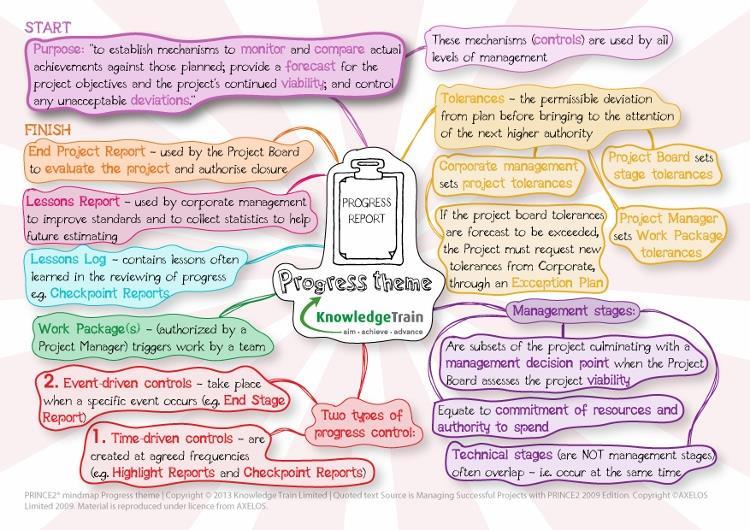
These mechanisms (controls) are used by all 3 levels of the project management team.
Tolerances refer to the permissible deviation from plan before bringing to the attention of the next higher authority. Corporate management sets project tolerances, the Project Board sets stage tolerances and the Project Manager sets Work Package tolerances. If the project tolerances are forecast to be exceeded, the project must request new tolerances from corporate management via an Exception Plan.
Management stages
- Are subsets of the project culminating with a management decision point when the Project Board assesses the (continuing) viability of the project.
- Equate to commitment of resources and authority to spend.
- Are mandatory - every PRINCE2 project has at least 2 management stages.
Technical stages (are NOT management stages) often overlap – i.e. they occur at the same time.
Monitoring and reporting on a project requires a time-based approach whereas controlling the project (i.e. decision making) requires an event-based approach. Therefore, PRINCE2 defines 2 types of progress control:
- Time-driven controls – are created at agreed frequencies (e.g. Highlight Reports and Checkpoint Reports).
- Event-driven controls – these take place when a specific event occurs (e.g. Exception Report).
Some other examples of event-driven controls are:
- Work Package(s) - authorized by a Project Manager in order to trigger the work of a team.
- Lessons Log - contains lessons often learned in the reviewing of progress e.g. Checkpoint Report.
- Lessons Report – used by corporate management to improve standards and to collect statistics to help future estimating.
- End Project Report - used by the Project Board to evaluate the project and authorise closure.
Summary
By now, if you have learned the definitions provided in bold in this e-book you should be well-placed to pass the PRINCE2 Foundation exam with flying colours. Good luck with your exam.
